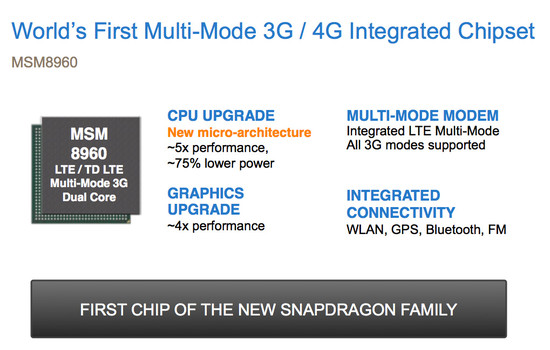Qualcomm has been one of the strongest actors on the mobile processor market and it has now presented the next generation Snapdragon CPU called Krait that will get up to four cores clocked up to 2.5 GHz. This is possible thanks to new 28nm technology that will go into test manufacturing in Q2 2011.
Qualcomm is one of few System-on-chip makers that doesn’t use ARM’s own processor architectures straight off the paper. Its Snapdragon circuits builds on ARM-licensed technology, but the architecture for the processors is Qualcomm’s own. Krait that is the next generation Snapdragon SoC will go up against Cortex-A15-based circuits from TI, NVIDIA and Samsung. The successor to Scorpion, Qualcomm’s current Snapdragon CPU architecture, will be ready for battle.
According to Qualcomm each Krait core will be 150% more powerful and 65% more energy efficient than current architectures. The exact circuits Qualcomm compares to we don’t know.
With 28 nanometer technology the cores will reach clock frequencies up to 2.5 GHz and from the looks of it the company will go with three models; single, dual and quad-core. Each circuit of the new MSM8xxx and APQ8xxx series will house a new Adreno GPU that will come with up to four GPU cores and be up to 15 times faster than Adreno 200. The three SoC solutions will be niched differently and the performance specifications can be found below.

| Qualcomm APQ8064 | Qualcomm MSM8960 | Qualcomm MSM8930 | |
| CPU cores | 4 | 2 | 1 |
| GPU | Adreno 320 (15 x Adreno 200) | Adreno 225 (8 x Adreno 200) | Adreno 305 (6 x Adreno 200) |
| GPU cores | 1-4 | 1-4 | 1-4 |
| Memory | LPDDR2/DDR3 | LPDDR2/DDR3 | LPDDR2/DDR3 |
| Modem | No | Yes, 3G/LTE (4G) | Yes, 3G/LTE (4G) |
| Launch | Around Q2 2012 | Around Q1 2013 | Around Q1 2013 |
According to Qualcomm the new Snapdragon family will support stereoscopic 3D, Near Field Communication (NFC), GPS, WiFi, Bluetooth and digital cameras with up to 20 Megapixels resolution. Even if we shouldn’t expect the first products with Qualcomm’s new circtuis until next year it is obvious that the development on the mobile market is going faster and faster.
















